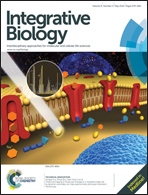Dynamic behaviors of astrocytes in chemically modified fibrin and collagen hydrogels†
Abstract
Astrocytes play a critical role in supporting the normal physiological function of neurons in the central nervous system (CNS). Astrocyte transplantation can potentially promote axonal regeneration and functional recovery after spinal cord injury (SCI). Fibrin and collagen hydrogels provide growth-permissive substrates and serve as carriers for therapeutic cell transplantation into an injured spinal cord. However, the application of fibrin and collagen hydrogels may be limited due to their relatively rapid degradation rate in vivo. In this study, immature astrocytes isolated from neonatal rats were grown in fibrin hydrogels containing aprotinin and collagen hydrogels crosslinked with poly(ethylene glycol) ether tetrasuccinimidyl glutarate (4S-StarPEG), and the cell behavior in these hydrogels was studied. The cell viability of astrocytes in the hydrogels was tested using the LIVE/DEAD® assay and the AlamarBlue® assay, and this study showed that astrocytes maintained good viability in these hydrogels. The cell migration study showed that astrocytes migrated in the fibrin and collagen hydrogels, and the migration speed is similar in these hydrogels. The crosslinking of collagen hydrogels with 4S-StarPEG did not change the astrocyte migration speed. However, the addition of aprotinin in the fibrin hydrogel inhibited astrocyte migration. The expression of chondroitin sulfate proteoglycan (CSPG), including NG2, neurocan, and versican, by astrocytes grown in the hydrogels was analyzed by quantitative RT-PCR. The expression of NG2, neurocan, and versican by the cells in these hydrogels was not significantly different.


 Please wait while we load your content...
Please wait while we load your content...